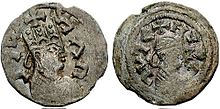Kaleb of Axum
| Kaleb of Axum ካሌብ Ἐλεσβαᾶς τῆς Ἀξωμιτῆς | |
|---|---|
 Coin of the Axumite king Kaleb
| |
| King of Axum | |
| Reign | 514–542 |
| Predecessor | Ousas |
| Successor | Alla Amidas |
| Born | Axum |
| Issue |
Israel Gabra Maskal Possibly Gebre Krestos (Gebru) |
King Kaleb: Saint Elesbaan | |
|---|---|
 | |
| King of Axum | |
| Venerated in |
Oriental Orthodox Churches Eastern Orthodox Church Roman Catholic Church |
| Feast |
|
Kaleb (Ge'ez: ካሌብ, Latin: Caleb), also known as Saint Elesbaan (Ge'ez: እለ አጽብሐ, Ancient Greek: Ἅγιος Ἐλεσβαᾶς), was King of Aksum, which was situated in modern-day Eritrea and Ethiopia.
Procopius calls him "Hellestheaeus", a variant of the Koinē Greek: Ἐλεσβαᾶς version of his regnal name, Ge'ez: እለ አጽብሐ, romanized: ʾƎllä ʾAṣbəḥa (Histories, 1.20). Variants of his name are Hellesthaeus, Ellestheaeus, Eleshaah, Ellesboas, Elesbaan, and Elesboam.
At Aksum, in inscription RIE 191, his name is rendered in unvocalized Gə‘əz as KLB ’L ’ṢBḤ WLD TZN (Kaleb ʾElla ʾAṣbeḥa, son of Tazena). In vocalized Gə‘əz, it is ካሌብ እለ አጽብሐ (Kaleb ʾƎllä ʾÄṣbəḥä).
Kaleb, a name derived from the Biblical character Caleb, was his given name. On both his coins and inscriptions he left at Axum, as well as Ethiopian hagiographical sources and king lists, he refers to himself as the son of Tazena.
Life
Procopius, John of Ephesus, and other contemporary historians recount Kaleb's invasion of Yemen around 520, against the Himyarite king Yūsuf As'ar Yath'ar, known as Dhu Nuwas, a Jewish convert who was persecuting the Christian community of Najran. After much fighting, Kaleb's soldiers eventually routed Yusuf's forces and killed the king, allowing Kaleb to appoint Sumyafa Ashwa, a native Christian (named Esimiphaios by Procopius), as his viceroy of Himyar.
As a result of his protection of the Christians, Kaleb is known as Saint Elesbaan after the sixteenth-century Cardinal Caesar Baronius added him to his edition of the Roman Martyrology despite his being a Miaphysite.
Axumite control of Arabia Felix continued until c. 525 when Sumyafa Ashwa was deposed by Abraha, who made himself king. Procopius states that Kaleb made several unsuccessful attempts to recover his overseas territory; however, his successor later negotiated a peace with Abraha, where Abraha acknowledged the Axumite king's authority and paid tribute. Stuart Munro-Hay opines that by this expedition Axum overextended itself, and this final intervention across the Red Sea, "was Aksum's swan-song as a great power in the region."
A historical record survives of a meeting between the Byzantine ambassador and historian Nonnosus and Kaleb in the year 530.
Ethiopian tradition states that Kaleb eventually abdicated his throne, gave his crown to the Church of the Holy Sepulchre at Jerusalem, and retired to a monastery. Later historians who recount the events of King Kaleb's reign include ibn Hisham, ibn Ishaq, and al-Tabari. Taddesse Tamrat records a tradition he heard from an aged priest in Lalibela:
Kaleb was a man of Lasta and his palace was at Bugna where it is known that Gebre Mesqel Lalibela had later established his centre. The relevance of this tradition for us is the mere association of the name of Kaleb with the evangelization of this interior province of Aksum.
Besides several inscriptions bearing his name, Axum also contains a pair of ruined structures, one said to be his tomb and its partner said to be the tomb of his son, Gabra Masqal. (Tradition gives him a second son, Israel, who, it has been suggested, is identical with king Israel of Axum.) This structure was first examined as an archaeological subject by Henry Salt in the early 19th century; almost a century later, it was partially cleared and mapped out by the Deutsche Aksum-Expedition in 1906. The most recent excavation of this tomb was in 1973 by the British Institute of Eastern Africa.
Issue and successors
A combination of literary, numismatical and epigraphical sources mention three sons of Kaleb named Gebre Meskel, Israel and Gebre Krestos, who all reigned as kings after him. Gebre Meskel (or Gabra Maskal) appears on several official regnal lists as the successor of Kaleb. Israel is recorded via coins issued in his name when we ruled as king. Gebre Krestos appears on only one known regnal list under the abbreviated name of Gebru. A Ge'ez inscription written in Sabaean characters states "Man of Hadafen, Son of Ella Asbeha, Gebre Krestos". Some historians have suggested that "Gebre Krestos" could be the throne name of Gebre Meskel, but this has not been definitively proven.